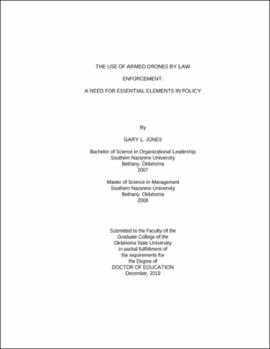| dc.contributor.advisor | Loffi, Jon | |
| dc.contributor.author | Jones, Gary L. | |
| dc.date.accessioned | 2020-06-26T21:28:00Z | |
| dc.date.available | 2020-06-26T21:28:00Z | |
| dc.date.issued | 2019-12 | |
| dc.identifier.uri | https://hdl.handle.net/11244/324888 | |
| dc.description.abstract | In 1936, Lt. Cmdr. Fahrney, Officer in Charge of the Navy's Radio-Controlled Aircraft Project, introduced the term drone in his semi-annual report for aerial targets. Later, in 1946, the United States military used the word drone to describe an Unmanned Aerial Vehicle. It had a two-fold meaning. First, drone was an Old English term meaning "male bee" and secondly, a "monotonous, sustained sound." Drones have played a huge role in military operations around the world and are being used on the front lines in the Unites States' war on drugs. Currently, 910 state and local agencies, including law enforcement, utilize drones in their day-to-day operations. Due to regulatory ambiguity, many law enforcement agencies have not developed acceptable policies on the use of armed drones. The purpose of this qualitative study was to conduct in-depth interviews of subject matter experts with professional knowledge and experience from three separate disciplines within law enforcement: drone operations, policy development, and legal counsel. A purposeful sample of 15 subject matter experts from all three disciplines were selected to participate in the study. Participant interviews were driven by three research questions pertaining to the development of policy; what current laws and regulations apply to the use of drones by law enforcement agencies, what elements are needed to insure the use of armed drones by law enforcement do not violate the Fourth Amendment rights of the citizens, and what basic elements of policy are needed to meet the minimum standards for an effective armed drone policy. Results of the interviews were analyzed to identify the essential elements of policy needed to provide law enforcement agencies with an effective baseline policy pertaining to the operation of armed drones and as a base for further research. Law enforcement is reactive by nature. The goal of this study was to provide law enforcement agencies and the aviation community with a knowledge base of information to assist in the development of regulations and policy prior to the implementation of armed drones in the field. This type of research in the area of unmanned aircraft policy is essential, in order to maintain the high level of standards the aviation and aerospace industry is accustomed to and to ensure the safe integration of armed drones into the domestic airspace. | |
| dc.format | application/pdf | |
| dc.language | en_US | |
| dc.rights | Copyright is held by the author who has granted the Oklahoma State University Library the non-exclusive right to share this material in its institutional repository. Contact Digital Library Services at lib-dls@okstate.edu or 405-744-9161 for the permission policy on the use, reproduction or distribution of this material. | |
| dc.title | Use of armed drones by law enforcement: A need for essential elements in policy | |
| dc.contributor.committeeMember | Bliss, Timm | |
| dc.contributor.committeeMember | Vance, Samuel | |
| dc.contributor.committeeMember | Sallee, Jeffrey | |
| osu.filename | Jones_okstate_0664D_16484.pdf | |
| osu.accesstype | Open Access | |
| dc.type.genre | Dissertation | |
| dc.type.material | Text | |
| dc.subject.keywords | drone | |
| dc.subject.keywords | law enforcement | |
| dc.subject.keywords | policy | |
| dc.subject.keywords | uas | |
| dc.subject.keywords | uav | |
| thesis.degree.discipline | Applied Educational Studies | |
| thesis.degree.grantor | Oklahoma State University | |
